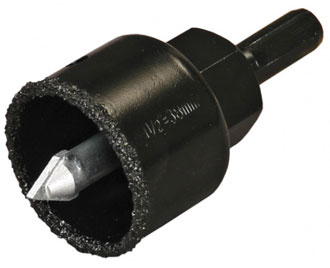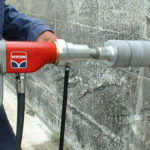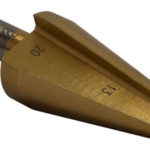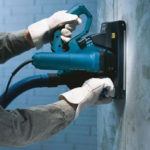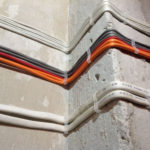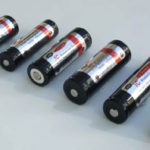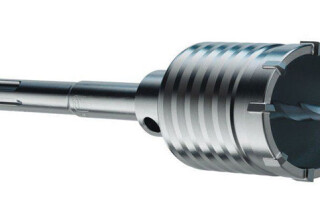When installing concealed electrical wiring in new buildings or in homes after capital repairs, you have to drill large diameter holes in the walls of concrete, brick to install electrical outlets. In this case, you use a drill, a rotary hammer or a drill rig with a special core bit for undercuts. This is a cylindrical nozzle with strong cutting segments. When rotating at high speed, the concrete drill bit easily penetrates the wall, forming holes for subroutines with smooth, even edges.
Contents
How is a crown bit made?
In household conditions, the teeth are mounted on rotary hammers or powerful (over 800 W) drill. For production purposes drill rigs are used. The tool is used electric or pneumatic.
Its design consists of three elements:
- Shank. At one end it has a thread for screwing on the nozzle and a hole to install the centering drill. The other end is fastened in a drill or rotary hammer. Sell shank extensions for drills with different types of chucks (SDS Plus, SDS Max).
- Centering drill bit is cylindrical or conical in shape. It reliably fixes the nozzle while drilling. The drill often gets blunt, it is periodically replaced. The conical shape drill bit is used with extended shanks.
- The crown is a section of pipe, on one side of which is a cutting edge, and on the other side a flange or shank for fastening in a chuck, hole punch or drill. In the sides of the socket bit holes are made to remove debris when drilling in concrete. It has 6 to 16 cutting tips that provide fast drilling at high RPM. The cutting bits are made of hard materials that easily cut stone, concrete, brick, tile or porcelain tile.
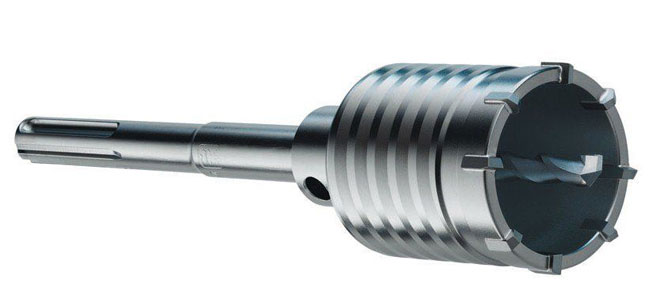
One-piece nozzles, designed for long-term use, are also sold.
Drill bit size for socket outlets
When planning the drilling work, you should select the correct diameter and size of the crown, so that the holes made correspond exactly to the size of the socket boxes and outlets to be installed. Major manufacturers offer boxes for sockets with a diameter of 65-68 mm and a depth of 42-47 mm. They require holes in the wall diameter of 68 with a drilling depth of 60 mm. The standard and most common drill bit diameter for socket holes is 68 mm and the working depth is 60 mm. The length and diameter can be smaller or larger, e.g. 70, 74, 82 mm.
Types of Bits
Depending on the material to be drilled and the technology, the crown under the socket is chosen. For domestic purposes, drill bits with different cutting edge materials are available:
- Carbide (pobedite or other alloys). The cutting edge has tungsten carbide tips on the cutting edge. Used for dry percussive drilling of several holes in domestic conditions.
- Tungsten carbide for drilling in stone, concrete, brick, crayon, ceramic tile. Not suitable for drilling reinforced concrete, as the cutting edges become unusable if they hit the reinforcement.
- Diamond-coated (diamond-powdered) for dry and wet (cooled) percussion drilling. The cutting part is coated with technical diamond chips. Suitable for reinforced concrete without limitations in terms of drilling depth and when a large amount of work is required.
According to the type of attachment of the cutting parts to the drills they are classified according to the shape of the shank
- with triangular shanks;
- Drill bits with hexagonal shanks for household needs;
- "SDS" and "SDS Plus". Their diameter (10 mm) corresponds to the connectors of the chucks of most models of perforators and drills used in the home;
- "SDS Top" diameter of 14 mm. For medium-sized rotary hammers;
- "SDS Max" diameter of 18 mm for professional equipment.
Shanks must fit the chucks of the tool used.
How to choose
Every beginner builder has to decide how to choose a drill bit so that it is easy to drill and inexpensive. When choosing them, you should consider the material of the walls, the drilling method, the size of the holes and their number, the financial costs.
Pobedite and carbide-tungsten devices with a small operating life on the number of holes are more affordable.
Diameter of undercutter crown should be equal to that of undercutter box.
Diamond and tungsten carbide-tipped drill bits are unsuitable for the percussion method. The diamond drill bit is used when drilling holes for undercuts in stone, granite, concrete, reinforced concrete. It is expensive, but it lasts a long time and is designed for repeated use.
When drilling in concrete, the tool can hit the reinforcement and fail. Before choosing the right drill bit, you should read the manufacturers' recommendations for their purpose and operation.
Diamond drill bit
The cutting edge of the cylinders contains individual segments that have a dusting of technical diamonds. Diamond chips cope with the hardest materials, even the reinforcement of reinforced concrete. They are labeled according to the strength of the sputtering:
- M - soft spraying for drilling tough concrete;
- C - medium-hard spraying for reinforced concrete;
- T - hard spraying is used when drilling high quality concrete at low RPM of the drill rig.
Diamond drill bits are divided into two main types:
- for dry drilling;
- for drilling with liquid cooling of the cutter.
The dry method is used to drill a concrete or brick wall in a domestic environment without impact, using drills or rotary hammers.
Cooled drills are used in industrial drilling rigs with a liquid supply to dissipate heat. They are designed for large hole depths or through hole drilling of solid concrete, granite or marble walls.
Dry drilling devices have a number of advantages:
- a long period of use;
- High drilling speed;
- applicability for drilling walls reinforced with metal nets;
- Minimal dust generation;
- preservation of the integrity of the walls when drilling;
- low noise level.
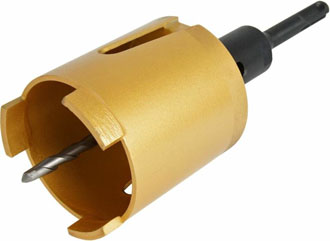
The disadvantages include the high price of nozzles (from 2000 rubles).
Pobedite .
Cutting edge of the nozzle is soldered with one of carbide alloys of tungsten carbide with cobalt and carbon, called pobedite in everyday life.
Pobedite is a durable alloy suitable for percussive drilling in simple concrete and brick. The pobedite tips crumble quickly if they come into contact with steel reinforcement. Carbide bits are actively used at home. The cost of such bits is from 400 rubles, which is quite suitable for performing drilling work with their own hands.

Carbide-tungsten drill bit
Nozzles with a cutting edge made of tungsten carbide are equally easy to drill concrete, brick and tile. It's handy when you want to make a hole for a socket in a tiled wall. The drill is designed to work with a drill or rotary hammer with a power of at least 800 watts without impact. When you hit the armature, the tungsten carbide drill bit is removed, so it is better to use carbide-tungsten drills in combination with diamond analogues of the same outside diameter. The price of carbide-tungsten devices from 250 rubles.
